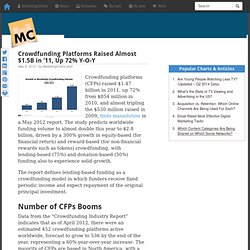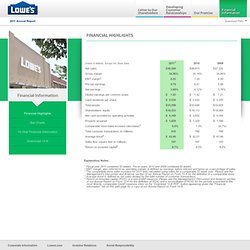

Crowdfunding Platforms Raised Almost $1.5B in ’11, Up 72% Y-O-Y. Crowdfunding platforms (CFPs) raised $1.47 billion in 2011, up 72% from $854 million in 2010, and almost tripling the $530 million raised in 2009, finds massolution in a May 2012 report.

The study predicts worldwide funding volume to almost double this year to $2.8 billion, driven by a 300% growth in equity-based (for financial return) and reward-based (for non-financial rewards such as tokens) crowdfunding, with lending-based (75%) and donation-based (50%) funding also to experience solid growth.
The report defines lending-based funding as a crowdfunding model in which funders receive fixed periodic income and expect repayment of the original principal investment. Number of CFPs Booms. S February 2013 Trend Briefing covering the consumer trend "VIRGIN CONSUMERS" The accelerating pace of innovation in the consumer arena means everyone is now at times, if not constantly, a VIRGIN CONSUMER – unfamiliar with many of the products, services, apps, experiences or brands they encounter every day.

However, far from being coy, VIRGIN CONSUMERS lust after, try out, and experiment with all these new brands, products, services and experiences more than ever. As long as brands make them effortlessly simple, intuitive, and yes, fun. Driving the explosion of VIRGIN CONSUMERS The fundamental driver behind the VIRGIN CONSUMER trend? NEWISM. Housing Perspectives (from the Harvard Joint Center for Housing Studies) PLANITDIY AND NASCAR UNITE.
HOME DEPOT ANNOUNCES LAUNCH OF FIRST FOR PRO PROGRAM. December 9, 2010 The Home Depot is taking a more proactive approach to capturing and retaining professional and contractor customers.

During a conference call, CEO Frank Blake announced the launch of the First for Pro program. The program is designed to cater to professional customers and provide the excellent shopping experience that pros want and deserve. “We are an unusual business since 4 percent of our professional customers account for almost 1/3 of our sales,” says Blake. “Yet, our average pro customer spends less than $5,000 per year with Home Depot.
During the conference call, Marvin Ellison, executive vice president for U.S. stores, expanded on the new initiative. Home Depot is going to have unique “pro power” hours to better cater to the customers and the hours they need to shop in the store. Ellison says that although the new program is in its early stages, he expects much improved service in for our pro customers thanks to this program. Category: HARDWARE RETAILING MAGAZINE. Daily updates and news from around the hardware and home improvement industry from the editors of magazine.

Industry's Momentum Evident at Ace Spring Convention February 22, 2013 — While Ace CEO Ray Griffith addressed the crowd at the General Session of Ace’s Spring Convention and Exhibits, his last time doing so before his retirement in March, he pointed to the co-op’s future leaders as the reason for the industry’s prospected growth. Read more » Category: Headlines CNRG Acquires W.T. Harvey Lumber February 20, 2013 — Central Network Retail Group, LLC (CNRG) recently acquired the operating assets of W.T. Hardware Retailing - JAN 2013.
Www.lowes.com/AboutLowes/AnnualReports/annual_report_11/includes/pdfs/Lowes_Form10K.pdf. Www.lowes.com/AboutLowes/AnnualReports/annual_report_11/includes/pdfs/Lowes_2011_Annual_Report.pdf. Lowe's Commercial "Can't Stand It" 2011 Lowes Annual Report. In 2011, we made progress on our journey to transform Lowe’s from a home improvement retailer to a home improvement company.

We remain steadfast in our efforts to make home improvement simple by working to deliver seamless, supportive and inspiring experiences wherever and whenever customers engage with Lowe’s. This work is well underway, and I am encouraged by the progress we made toward delivering better customer experiences to drive long-term sales growth, increased profitability and shareholder value. Our strong operating cash flows and balance sheet are allowing us to make difficult near term changes that we believe will yield stronger returns in the future. 2011 Performance For the year, comparable store sales were flat and total sales grew 2.9%. Our Transformation We are working diligently to improve our performance over the long-term through the transformation we have undertaken from a home improvement retailer to a home improvement company. Retail Excellence Seamless Simple. The Home Improvement Market by Packaged Facts in Home Building & Improvement, Do-It-Yourself, United States.
Countries covered: United States This study analyzes the growing market for do-it-yourself (DIY) home improvement in the United States.

The main products covered in this report include: lumber, building materials, doors and windows, plumbing products, architectural coverings, paint, adhesives and sealants, and tools and hardware. The report provides coverage of market size and growth, with sales projected to the year 2000. It also includes profiles of the leading corporate competitors in the market and an examination of important new trends in the home improvement industry. Scope and Methodology The home improvement market is not an easily measured, clearly distinct market. Do-It-Yourself (DIY) Consumers in the U.S.: DIY Markets in a Down Economy.
Publication date: June 2009 Keywords : DIY, Garden Equipment, chain As the worst economic downturn in living memory stretches relentlessly into 2009, American consumers in every walk of life are searching for new ways to cope with their diminished financial circumstances and to empower themselves by taking more control of their lives in uncertain times.

One increasingly popular survival strategy adopted by more and more American consumers is to take on routine chores and tackle major projects themselves rather t... Search ReportLinker The Largest Collection of Market Research Reports » 1.2 Million Industry Reports » 450,000 Company Profiles » 850,000 Market Briefings » 40,000 Country Guides. 70 Percent of Affluent Homeowners Looking to DIY Projects to Save Money. According to the Summer 2012 Merrill Edge Report, many mass affluent Americans are willing to make short-term sacrifices in order to get their finances in better shape.

The report, released on April 26 by Bank of America, explores the financial concerns and priorities of mass affluent consumers, Americans with $50,000-$250,000 in investable assets. This group, which consists of approximately 28 million households in the United States, has also shown over the last six months a rising concern over a number of financial issues, such as the cost of healthcare and being able to afford the lifestyle they want in retirement. Do-It-Yourself (DIY) Consumers in the U.S.: DIY Markets in a Down Economy : Packaged Facts. Special offer: now 20% off original price of $3,080 As the worst economic downturn in living memory stretches relentlessly into 2009, American consumers in every walk of life are searching for new ways to cope with their diminished financial circumstances and to empower themselves by taking more control of their lives in uncertain times.

One increasingly popular survival strategy adopted by more and more American consumers is to take on routine chores and tackle major projects themselves rather than paying others to do them. Home Improvement - US Market Report & Market Share. Consumer Demographics : Marketing Case Study of Home Depot and Best Buy. Although the largest demographic, population wise, may be that of the aging Baby Boomers, retailers tend to agree that one of the most important consumer demographics is college-educated adults in their late 20s and early 30s who have not yet had children (Huntley, 2006).

Despite the fact that it is this consumer group that has been saddled with the label of “generation debt,” many having taken out student loans that will require decades to repay and having come-of-age during the height of the credit card era, Huntley (2006) describes this particular consumer sector as “startlingly optimistic” (p. 46). Battle of the Retail Heavyweights: Lowe's vs. The Home Depot. Since RetailWire is all about discussion, we thought it might be fun to have a good, old-fashioned "retail rumble" - take a pair of notable retailers, and ask our expert BrainTrust panel and readers to tell us who does the better job. For our first effort, we'll take a look at a pair of real heavyweights, Lowe's and The Home Depot. First, here's the "Tale of the Tape": The Home Depot and Lowe's are both clearly success stories, with nearly 4,000 stores between them. While "The Great Recession" wasn't kind to either retailer or the home improvement category, it gave each the opportunity to get back to basics.
Customer Insight. Publication date: May 2012 Report size: 68 pages. Customer Insight.